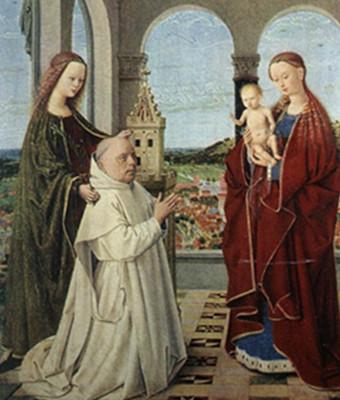Books and Arts; The work of Cima da Conegliano;
文艺;西玛·达·科内利亚诺的作品;
An overlooked master;Venice comes to Paris;
沙海遗珠;威尼斯走向巴黎;
Tall, lean and with a head of brown curls, St John the Baptist's intense expression seizes the viewer's gaze. The enthroned Virgin holding the Christ child may be the subject of this late-15th-century painting, yet the eye is drawn to the saint (pictured, detail). He feels real, somehow, with the magnetism of a rock star. This is a quality found in many of the saints portrayed by Giovanni Battista Cima, called Cima da Conegliano.
高大瘦削,一头棕色的卷发,施洗者圣约翰紧张的表情抓住了观众的目光。圣母抱着圣婴可能是这幅十五世纪晚期绘画的主题,但人们的视线还是被圣徒吸引(如图,局部)。不知怎的,他让人感觉真实,有摇滚巨星般的吸引力。这是被称为西玛·达·科内利亚诺的乔瓦尼·巴蒂斯塔西玛所绘众多圣徒身上共有的特质。

Readers can be forgiven for not recognising the name. Born in 1459, Cima became a painter during the blossoming of the Italian Renaissance. It was an inspiring time to be an artist, but the competition was fierce. He worked in Venice, where Giovanni Bellini was already established. By the time Cima died in 1517/18, Giorgione and Titian had made their marks. The fame of these artists has overshadowed Cima's. It is a shame. Bernard Berenson, one of the most influential writers on the Venetian Renaissance, said of him: “No other master of that time paints so well the pearly light that models the Italian landscape with a peculiar lightness and breadth.” Cima's depiction of the landscape influenced his more famous contemporaries. Now visitors to Paris are being offered the chance to make his acquaintance. “Cima da Conegliano: Master of the Venetian Renaissance” at the Luxembourg Museum is a wonderful show.
读者没听过这个名字可以谅解。西玛出生于1459,是意大利文艺复兴全盛时期的画家。这一时期是艺术家辈出的时代,但竞争激烈。他曾在威尼斯作画,而乔瓦尼·贝利尼已在威尼斯大放异彩。到1517 /18年西玛去世的时候,乔尔乔内和提香也成名了。这些艺术家的名声盖过了西玛。这是一个憾事。伯纳德·贝伦森是威尼斯文艺复兴方面最有影响力的作家之一,他说:“当时没有别的大师可以用独特的浅淡颜色以及幅宽把意大利风景画得如此流光溢彩。”西玛对风景的描画影响了比较有名的同代人。现在巴黎的游客有了了解西玛的机会。卢森堡博物馆的画展《西玛·达·科内利亚诺:威尼斯文艺复兴时期的大师》是一场精彩的展览。
Cima painted in tempera and oil on wood. Such pictures are notoriously fragile, yet this exhibition features 30 works, all of them on wood panels. The loans have come from churches, museums and private collections—evidence of the diplomatic talents of Giovanni Villa, the show's curator. They include half-lengths of the Virgin and Child made for private devotion; full-sized portrayals of saints; and scenes from classical mythology, including Theseus slaying a rather handsome minotaur. The smaller pictures are gripping, but the large altar paintings are the main attraction. Many hang on free-standing panels, and their warm, rich colours sing out in rooms of slate grey. The show is big enough to suggest the artist's range, but small enough to encourage private contemplation. Cima has captured the light and mood of the Veneto. Paris falls away and the visitor is transported to Venice.
西玛用油彩在木材上作画。众所周知,这种画十分娇贵,而本次展览展出的30件作品全放在木制嵌板上。展出的画都是从教堂、博物馆和私人收藏借来的,显示了展览策展人乔瓦尼·费拉的外交才干。这批画包括画来送人的圣母圣婴半身肖像画;还有圣徒的全身肖像画;以及古典神话中的场景,其中有忒修斯杀死一个相当漂亮的人身牛头怪物。小幅的画扣人心弦,而大型的圣坛画更具吸引力,是主要吸引参观者的画作。许多画挂在独立的嵌板上,它们丰富的暖色在瓦灰色的展室里绽放。这场展览规模大到足以表明艺术家的定位,但也小到足以引人沉思。西玛捕捉到了意大利威尼托区的光线和色调。巴黎消失了,参观者被送到了威尼斯。
The show opens with Jacopo de' Barbari's famous bird's-eye view of the city. This enormous map, a masterpiece of Renaissance printmaking, was published in 1500 when Cima lived there. A small copy pinpoints Cima sites, including that of his studio in San Luca near the Rialto Bridge.
画展以雅格布·德·巴巴里著名的威尼斯鸟瞰图开始。这个巨大的地图是文艺复兴时期的版画杰作,1500年西玛住在威尼斯的时候出版的。在一幅小型复制图上用针标出了西玛住所的精确位置,包括他在里亚尔托桥附近圣卢卡的工作室位置。
The altar painting of the Virgin mentioned above soon follows. It was commissioned for the Duomo in Cima's hometown, and has remained in that Conegliano church since 1492. Some complain that church art loses its force when displayed out of context. Yet each element, from the stylised foliage of the dome above to the angel musicians below, is far easier to see and appreciate in Paris than it is in Conegliano. Cima often painted the same models. The viewer meets St John the Baptist, St Catherine and St Jerome (and his lion) more than once walking through this show. The result is a warm and welcome sense of familiarity, rather than the feeling that one is looking at actors in a series of religious tableaux.
上面提到的圣母玛利亚的圣坛画紧随其后。这幅画是受托为西玛家乡的大教堂画的,自1492年起一直保存在科内利亚诺教堂。有人抱怨说,脱离了背景进行展示,教堂艺术就失去了它的感染力。然而,从上面圆顶千篇一律的叶饰到下面的天使音乐家,每个元素在巴黎都比在科内利亚诺更容易领会欣赏。西玛经常画相同的画面形象。看过整个展览的观众会不止一次地见到圣约翰、圣凯瑟琳和圣杰罗姆(以及他的狮子)。结果观众感到的是温暖愉悦的熟悉感,而不是那种在一系列宗教舞台造型中看着演员的感觉。
The exhibition ends as it begins, with Venice. In a very large work, the winged lion of St Mark—symbol of both the saint and the city he founded—fills most of the painting. The four saints who flank him appear pint-sized in comparison. Whatever else the picture was meant to signify, it is plain that the aim was to show the overwhelming power of Venice. Bubbly Prosecco, a better-known product of Conegliano, is for sale in the museum shop. New and old admirers of Cima may well wish to raise a glass to this underappreciated master.
展览以威尼斯开始,也以威尼斯来结束。在一件非常大型的作品中,圣马可的飞狮填满了大部分画面,这个飞狮既是圣马可的标识,也是他所守护的城市威尼斯的标识。比较而言飞狮侧面的四个圣徒看起来比标准的要小一些。不管这幅画还意指别的什么,显然其目的是为了显示威尼斯的征服力。博物馆的商店内出售普罗赛克香槟酒,该酒科内利亚诺较知名的产品。西玛的新老崇拜者也许很希望为这个怀才不遇的大师举杯。













